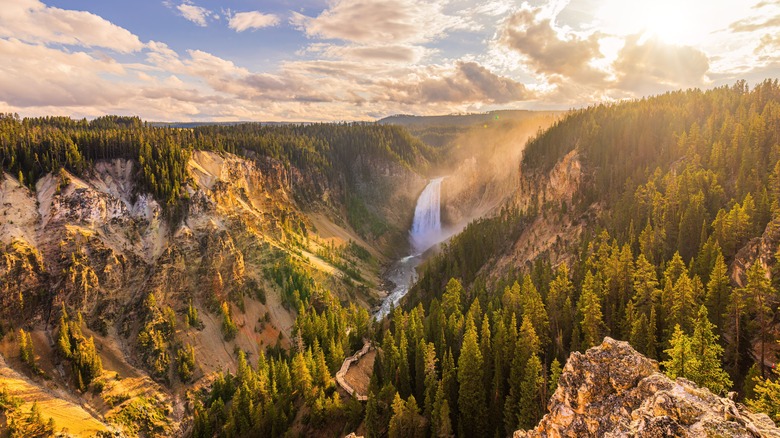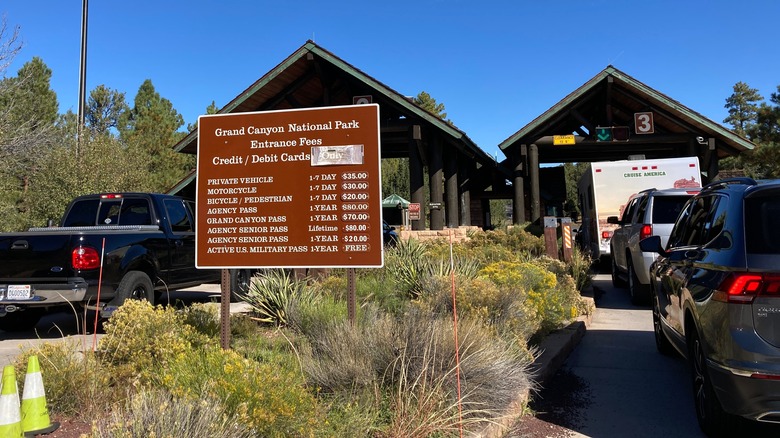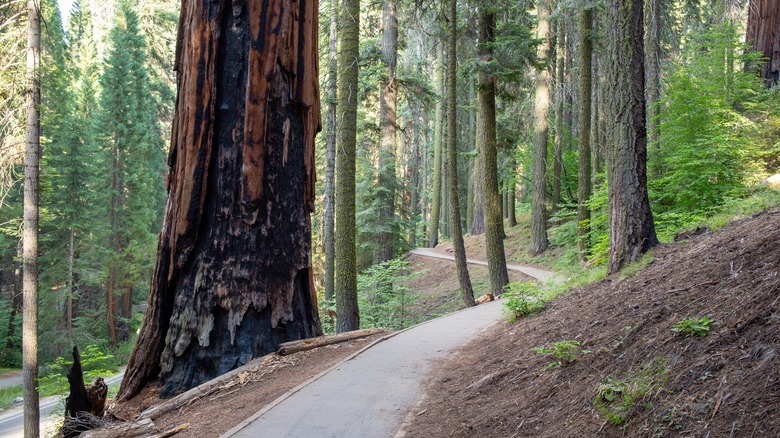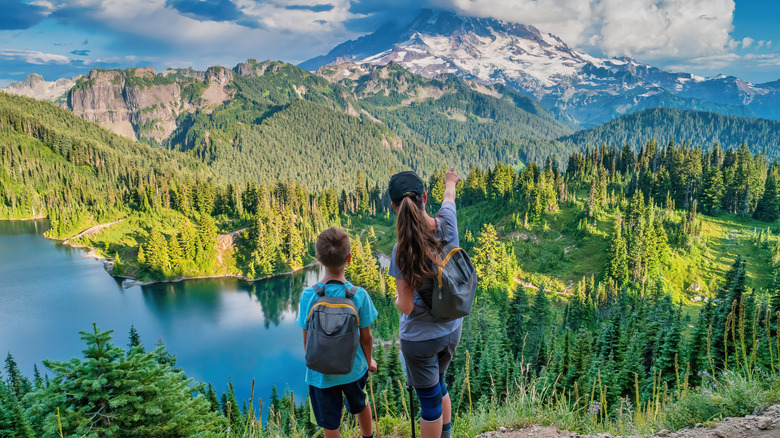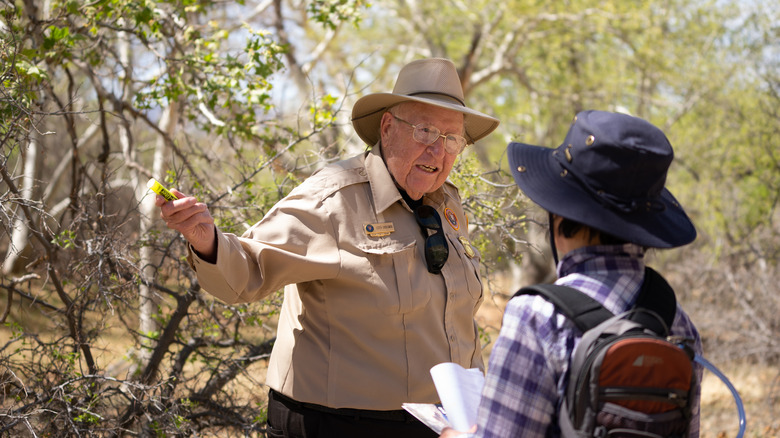Free National Park Passes You May Not Realize You Qualify For
Roughly one-quarter of America's national parks offer free admission. This includes the country's most-visited national park in the Great Smoky Mountains and its most recently established park in the New River Gorge of West Virginia. When you're cruising down Highway 101 on a California national park road trip, you can drive through Redwood National Park without even having to pass through an entrance gate. However, not every park offers such unfettered access — unless you happen to qualify for a free entrance pass.
U.S. military personnel, their dependents, Gold Star families, veterans, disabled people, fourth graders, and federal recreation site volunteers all might qualify for such a pass. Each is eligible for a free version of the otherwise amazingly affordable America the Beautiful pass. It's your ticket to any national park and is available for anyone to purchase as an annual pass. You can also use it at any other site in the National Park System, including national memorials and monuments like Mount Rushmore and the Statue of Liberty.
U.S. citizens and permanent residents aged 62 and up can get the Senior Annual Pass for only $20.00. The cost of a Senior Lifetime Pass — $80.00 — is the same as the cost of a regular Annual Pass for everyone else. Apart from those options, there are select days when you can visit any U.S. national park for free. If you're eligible for one of these five passes, though, they will let you enter the parks for free any day of the year.
Military Annual Pass
When you're a member of the U.S. Army, Air Force, Navy, Marines, Coast Guard, Space Force, or National Guard, you should be eligible for a Military Annual Pass. This free pass is also available to cadets, active reservists, and dependents of U.S. military members. The National Park Service (NPS) provides it as a thank you to military personnel and a way for them to explore the very country they've dedicated their lives to defending.
Again, the Military Annual Pass and every other version of the America the Beautiful pass are good for admission to any site in the National Park System. Check the NPS website for the nearest place where you can pick up your pass, or you can order one online via the USGS (U.S. Geological Survey) store for a processing fee of $10. Either way, you'll need to provide government-issued documents showing your branch of military service and your current status or affiliation.
When you're driving in, some NPS sites charge one flat entrance fee per vehicle, as in the case of Maine's Acadia National Park, where you can be the first to watch the country's sunrise. With those sites, your Military Annual Pass will cover you and all the passengers in your vehicle. Other popular sites, such as Arizona's Grand Canyon National Park, charge an individual entrance fee per person. In cases like that, your pass will cover you and up to three additional adults aged 16 or over.
Military Lifetime Pass
At America's national parks, Gold Star families and veterans of the U.S. Armed Forces are set for life with free admission. The USGS defines Gold Star families as "next of kin of a member of the United States Armed Forces who lost his or her life in a 'qualifying situation,' such as a war, an international terrorist attack, or a military operation outside of the United States while serving with the United States Armed Forces." The Military Lifetime Pass is geared specifically toward those families and veterans, whereas the Military Annual Pass is more of a short-term fix for current soldiers looking to travel within the next year.
The method of obtaining a Military Lifetime Pass (in person or online) and using it to enter a national park with other car passengers is the same as outlined above for the Military Annual Pass. You can also download a Gold Star Voucher here, trade it for a pass when you're at the park, or put it on your dashboard with the bar code visible. Some parks have automated entrance gates, but if you want to access the fast pass lane at Rocky Mountain National Park, you'll need to purchase a new $15 transponder and affix it to your windshield. Veterans, meanwhile, can use several different forms of ID as documentation. These include a veteran ID card, veteran health identification card, Department of Defense identification card, or a state-issued driver's license with the veteran designation.
Access Pass
Certain national parks have made a concerted effort to improve accessibility for disabled people. Two examples are the neighboring Sequoia and Kings Canyon, where you can experience some of the largest trees in the world. For free entry into these parks, you can use the Access Pass, another lifetime pass available to disabled U.S. citizens or permanent residents.
To qualify (per the guidelines), your disability must be medically deemed "a permanent physical, mental, or sensory impairment that substantially limits one or more major life activities, such as caring for oneself, performing manual tasks, walking, seeing, hearing, speaking, breathing, learning, and working." As with the military passes, you'll need to provide documentation when you apply online or in person. In this case, that means a statement by a licensed physician or a document issued by a federal agency, such as the Veteran's Administration or Social Security Administration (showing your disability income).
Just displaying a handicapped parking permit at the entrance gate to a national park won't be enough. For federal recreation sites without entrance stations, they do issue free hangtags and decals, and you might need to show one of those or your pass to a compliance officer. To acquire an Access Pass, you'll also need to prove your citizenship or permanent residency with identification like a driver's license, passport, green card, or birth certificate. They'll print your name as shown on your pass, which needs to match the one on your vehicle registration for the decal.
4th Grade Pass
If you're a kid in the fourth grade (or you have one in your family), it turns out that's the magic number for free entrance to national parks. The 4th Grade Pass is available through the U.S. government's Every Kid Outdoors program. While the number may seem arbitrary, there's a reason they've singled out that grade level for the pass. On its parents and guardians page, the program's website explains, "We chose fourth graders because research shows that kids ages nine to 11 are beginning to learn about the world around them. They're open to new ideas, and they are likely to connect to nature and our history."
To get their pass, kids play a quick Choose Your Own Adventure-style game on the website, where they input things they want to see and do in a diary. Options include "Time Travel!" and "Go on a Nature Walk!" Once they're through with this exercise, they can enter their zip code and print a paper voucher with a unique bar code, guaranteeing free admission to "all federal lands and waters."
Admission is also free for family and friends, as long as there are no more than three adults and everyone else is under 16 (at parks that charge per person). The pass relies on the honor system; kids don't need to submit elaborate documentation proving they're in the fourth grade. It expires at the end of August, so kids can use it throughout the academic year and summer vacation.
Volunteer Pass
Entering national parks for free might make you feel like you're receiving VIP treatment, but for the National Park Service, that acronym has a different meaning: Volunteers-in-Park. The Volunteer Pass is a free one-year pass for "VIPs" who have logged 250 hours of service at federal recreation lands across the U.S. It's not just the NPS that manages these lands; there's also the Bureau of Land Management, Bureau of Reclamation, Fish and Wildlife Service, USDA Forest Service, and U.S. Army Corps of Engineers.
The America the Beautiful pass covers all the places overseen by those agencies. Through Volunteer.gov, you can find hundreds of volunteer opportunities, even virtual ones, at participating sites. Examples include serving as a campground host or a train guide through the Trails and Rails program. You could warm up for the latter by visiting popular national parks on a scenic Amtrak train.
Since you'd effectively be working for 32 cents an hour, you probably shouldn't start volunteering just to secure a $80 Annual Pass for free. The Volunteer Pass is more of a humble bonus for VIPs who have given 250 hours of their time back to the national parks community. You'll need a record of the hours you worked, signed by your volunteer coordinator, who will then issue your pass. If you want to split your volunteer time between different places, that's also okay. In the end, there's perhaps no better way to see national parks for free than volunteering your time freely.
